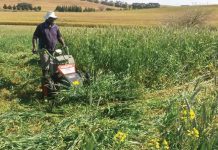‘The agricultural industry cannot be self-sufficient when 70% of wheat and 80% of soybeans are planted with farm-saved seed. This will lead to less investment in new cultivars and breeding programmes, which will, in turn, influence the yield.’
This is according to Mr Andries Theron, producer and co-opted Executive member of Grain SA, who addressed the media and industry role-players at the SA Cultivar and Technology Agency (SACTA) launch in November last year.
‘The average yield for wheat in my production area in the Western Cape is 3,2 t/ha and for barley it is 4,5 t/ha to 5 t/ha. The reason for this low yield is because of a lack of new technology for self-pollinated crops (wheat, barley, soybeans and some canola cultivars).’ According to Theron producers were feeling the effect of the vicious circle caused by farm-saved seed and were the first to propose a solution to this problem. ‘It was proposed that a sustainable seed funding programme needs to be implemented. Subsequently the breeding and technology levy was established and SACTA was created to administer it,’ he said.
The role of the wheat breeder
Dr Francois Koekemoer (research director, Sensako) addressed, amongst other matters, a wheat breeder’s requirements to release successful wheat varieties into the market.
‘The breeder needs to breed for an ideotype or acceptable phenotype. The ideal ideo-/phenotype requires a variety that has acceptable and stable yield levels, proper insect, disease, abiotic and biotic stress resistance/tolerance levels and acceptable grading and processing quality,’ he said.
Dr Koekemoer said that a wheat breeder has to accommodate up to 40 to 50 more characteristics simultaneously or at different levels of selection.
End-point royalty (EPR) system
‘Despite progress with regards to wheat quality and yield simultaneously, hectares are the lowest in the history of wheat production in South Africa,’ Dr Koekemoer said.
He said that the EPR system that was implemented in 2017 and managed by SACTA, will increase the income of farm-saved seed. ‘This will enable breeding programmes to afford better equipment, tools and infrastructure and participate with international expertise. This is a system where a holder of plant breeders’ rights exercises its right to a fee on the grain produced rather than on the seed used or sold.’
Mr Gert Heyns (marketing manager: Seed and Biotechnology, Monsanto) highlighted three of the benefits of this self-regulatory system:
- All grain of a specific crop is levied at first point of sale.
- All growers pay the same levy.
- Producers and breeders share the risk (if producer income is low due to drought etc., the levies are also lower and the income is directly linked to the level of variety performance).
Heyns wants to call on producers to in future adopt an attitude of declaration and openness by declaring the variety that was grown and delivered and declaring the technology (bio-tech and other).
The role of SACTA
According to Heyns, SACTA is supported by grain producers and collects the levy from them. ‘In the past breeding was funded per project and not necessarily on performance.’
Heyns said that SACTA believes that ‘cultivars should offer a healthy balance between yield and quality, cultivars should be driven by the free market, dictated by demand and that the industry should not lose its competitive advantage in terms of quality’.
Transformation
He said that as this is a statutory levy, 20% of all distributable funds will be allocated to transformation. ‘Breeding companies will have the responsibility to apply such funds according to the National Marketing Council’s guidelines for transformation. The relevant trusts will also have levies and the joint pool of funds will increase significantly, benefiting transformation.’
Heyns used wheat as an example. ‘Producers are now paying R35/ton (Winter Cereal Trust: R10 and SACTA: R25), where in the past they paid R17/ton. The total levy has more than doubled. There will therefore be considerable additional funds available for
transformation.’


















